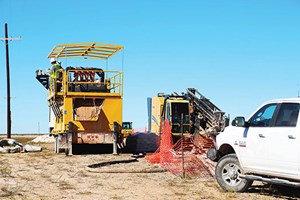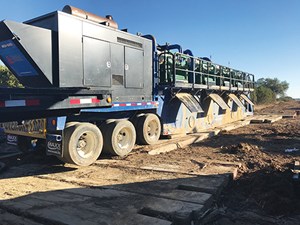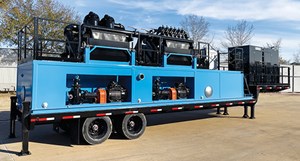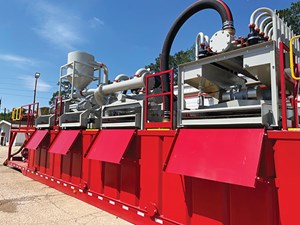April 2022 Vol. 77 No. 4
Features
Modern mud systems bring large benefits to big HDD jobs
By Jeff Awalt, Executive Editor
In today’s environment of strict environmental regulations, rising costs and intense competition for horizontal directional drilling (HDD) jobs, mud reclaimer systems have become an indispensable companion to large-diameter HDD rigs.
With roots in the oil patch and decades of refinement to meet a range of applications, these multi-component systems enable HDD contractors to clean and reuse water continuously while capturing solids and improving the efficiency and environmental compliance of their operations.
“What these cleaning systems provide is the capacity to operate efficiently on a job site,” said Richard Levings, product manager at American Augers. “And because of the science and technology going into today’s systems, they’re able to remove more solids and send cleaner fluid back through the pump, which reduces contractors’ operational costs because they’re not having to rebuild their pumps as often.”
For HDD contractors facing inflationary pressures and limited project opportunities, especially in the oil and gas sector, packaged mud systems can help reduce costs and operate on tighter margins, adds Marv Klein, Pipeline Segment application specialist at Vermeer.
“Mud reclaiming systems are typically used on large HDD projects. They’re not specifically economical and justifiable to work on more small-diameter projects like you see a lot of times in the utility market for telecom work and things like that,” Klein said.
“When you start to get into larger projects – larger diameters, larger lengths – your mud buoyance increases dramatically, and that’s where it starts to become more economical to utilize the mud reclaiming system.”
System elements
Designs and capabilities vary by market and manufacturer, but all of them rely on the same essential pieces and processes to recycle drilling fluid, rather than continuously remix and dispose of waste according to strict regulation.
Mud tank – The mud tank contains the drilling fluid that is pumped downhole during drilling. All of the other equipment is connected to the mud tank.
Shale shaker – The shale shaker is the first step in the solids separation process for drilling fluid after it returns to the surface carrying solids. It uses vibration and screening panels to remove the largest debris.
Vacuum degasser – Gases can form during the drilling process, causing bubbles to appear in the drilling fluid. The vacuum degasser separates the gases from the fluid.
Desander and desilter – Also called a mud cleaner, the desander and desilter remove respectively smaller solids that survived the shale shaker.
Centrifuge – The centrifuge is the final hydro cyclone in the process and is used to remove the finest solids before the clean drilling fluid is pumped back into the mud tank for recycling.
Ray Pietramale of Elgin Separation Solutions explained that shale shakers, which have been in use since the 1930s, might reduce solids down to around 80 microns, as an example, based on screen configuration.
“Then, if you put a hydro cyclone manifold into the next line of operation, that’s going to cut solids down to 25 microns. So, anything that’s 26 microns or higher gets disposed of and hauled away,” Pietramale said.
“That’s the perfect kind of (solids size) range, because you have additives like barite and bentonite in the fluid, and the idea is not to strip that out, because then you’ll have to throw a lot more back into the fluid.”
Systems are rated according to their cleaning capacity in gallons per minute, with different brands offering units ranging from 100- to 1,500-gallons per minute (GPM). Those measures are based on hydrostatic testing with water, so rates in the field will vary depending on specific fluids and operating conditions.
HDD rig operators can adjust the angle of shale shakers to control how long it takes material to pass over the trays, a measure known as “residence.” This allows more time for solids separation when dealing with, say, gumbo soil in Southeast Texas, versus sandier soil farther west.
“When I think about these systems overall, including equipment made by my competitors, I think all of us believe that the reclaimer and solids control industry adds real value to drilling, whether it’s a water well or HDD,” said Triflo’s Jerry Turk, describing the environmental benefits of mud recycling as leaving a “green footprint” on jobsites.
It’s a common refrain among manufacturers to tout the environmental benefits of mud recycling, and for good reason. Modern solids control systems can reduce the need for chemical reagents by 15-20 percent, lowering operating costs and potential environmental impact. By removing solids in drilling fluid and mud, less waste ends up in landfills.
Market trends
Just as contractors are under pressure in the current market, manufactures of mud cleaning systems also are recovering from the pandemic downturn and lower midstream capital spending – including the loss of several major pipeline projects that were delayed to death or killed outright through environmental and political opposition.
Now, rising costs for raw steel and other materials and pricier supply chains are driving manufacturers to seek operating efficiencies to help keep a lid on equipment prices.
“It’s been a cycle that has definitely challenged all of us to look at ways to streamline our manufacturing to keep costs down, so that we’re not having to impose a drastic increase that it ends up hurting the customer,” said Pietramale.
Manufacturers say business is gradually improving and somewhat diversifying since the pandemic downturn reduced energy demand and several major pipeline projects were shelved. Some OEMs report more activity in non-U.S. energy markets and in municipal and power markets.
Those conditions may be conducive to good deals for buyers in the near-term, but they also have a downside. When oil and gas drilling activity was higher, orders might call for four-week delivery. With reduced inventories during a period of recovery, lead times for some systems are averaging around 18–20 weeks.
“With supply chain and inflation,” one industry source told Underground Construction, “it’s not practical to build a stock of $200,000 to $300,000 units that could sit on the books for 12 months.”
For the foreseeable future, then, it appears that many large-diameter HDD contractors shopping for new mud cleaning systems will be buying made-to-order equipment.
With the major evolution of mud systems complete, manufacturers are now largely focused on operating refinements, safety innovations and feature improvements of their systems. Some of these incremental advancements occur in small but meaningful ways. Shaker screens, for example.
Traditionally a metal tube frame with a stainless-steel punch plate on top and layers of wire cloth, the screens are designed much like window screens, bonded together to make what are known as polyester powder-coated pre-tension screens. They’re effective but can de-laminate, and wire cloth is prone to damage. New composite screen technology allows the production of a polyurethane molded screen with wire cloth and reinforced steel all in a composite frame that is made in a single pass.
Other refinements have included the reduced use of catwalks for safety, improved access to pumps and critical controls, and noise-reduction technologies for compliance in populated areas.
Manufacturers have been equipping their systems with onboard Wi-Fi for several years. The next big step will be in the advancement and integration of automation and control-panel technologies that utilize those systems, said Pietramale.
New offerings include remote monitoring and management of key systems using iPads or devices, so drillers can receive alerts and respond without physically touching the rig.
With such emerging capabilities and an improving outlook for energy markets, manufacturers anticipate an increasingly bright future for these efficient and environmentally friendly systems.
FOR MORE INFORMATION:
Elgin Separation Solutions, (281) 261-5778, elginseparationsolutions.com
Triflo International, (936) 856-8551, triflo.com
American Augers, (800) 324-4930, americanaugers.com
Vermeer Corp., (888) 837-6337, vermeer.com








Comments